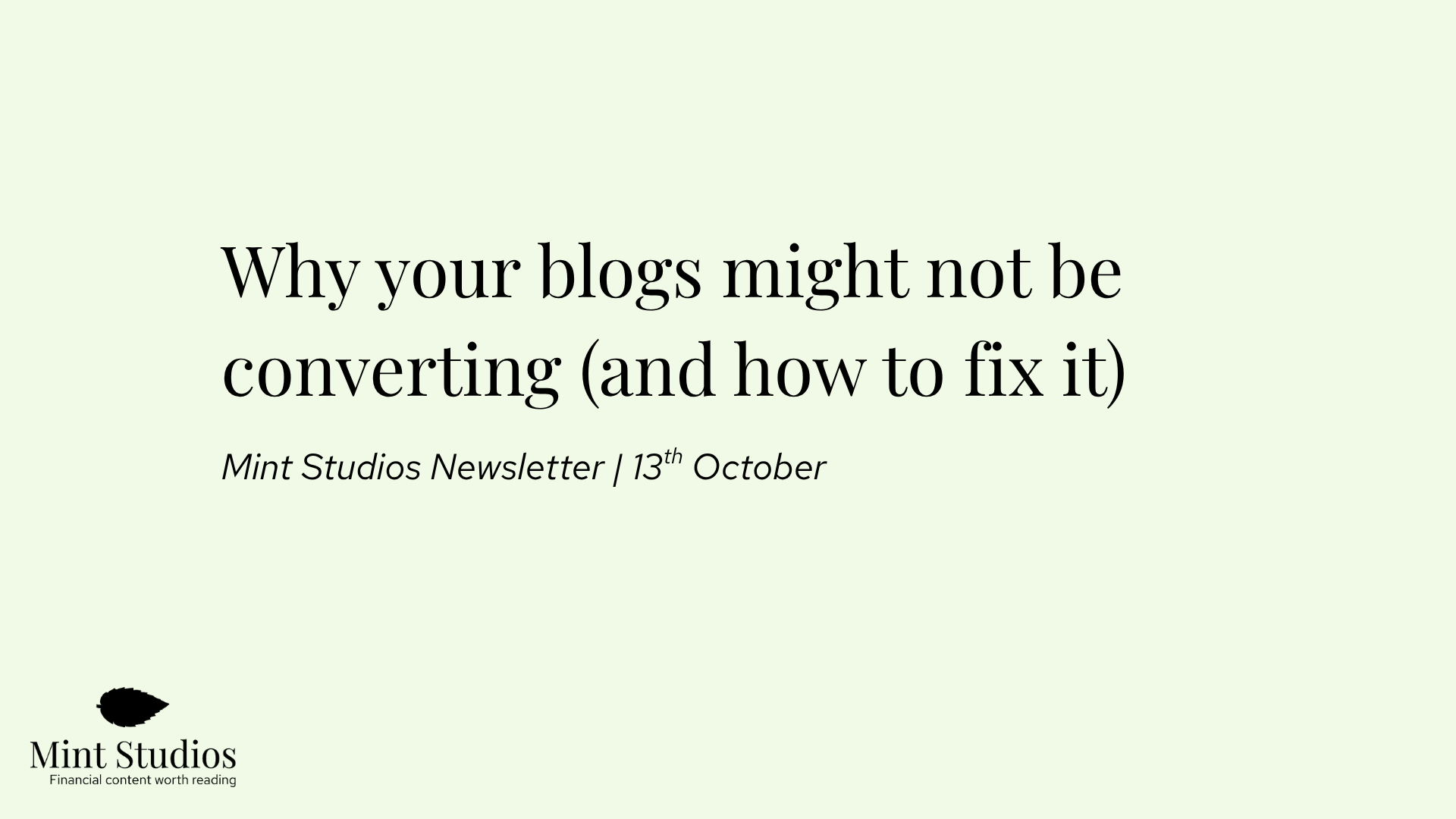If you’re doing research on fintech marketing strategy, it’s likely that you’re either looking for inspiration and guidance on where to get started.
As with anything related to strategy, we can’t tell you what strategy will work best for your fintech company. What we can do, however, is showcase some fintech companies that have done an excellent job executing on their marketing strategy, and hopefully provide some inspiration for your own marketing strategy.
In this article, we’ll start off by setting a few things straight about strategy, and then go through some examples of fintech companies executing on marketing.
Note: join our newsletter to get fintech marketing and content marketing tips in your inbox every month.
A fintech marketing strategy is not a list of tactics
If you look up “fintech marketing strategy” online, you’ll see a generic summary of what a strategy is, along with a list of tactics.
Don’t worry, we’re not going to start giving you a generic definition of strategy (which you probably already know). Instead, we’ll take the time to differentiate between the two.
To us, a strategy is simply:
- Figuring out what your product does best (your competitive advantage).
- Finding an opportunity in the market, something that has been ignored or that competitors are not focused on.
- Combining the two: taking your competitive advantage and using it to take advantage of an opportunity.
If you want to get deep into strategy, a great book on this topic is “Good strategy bad strategy” by Richard Rumelt. In the book, Rumelt explains how, with strategy, Hannibal was able to defeat the Romans with an army half the size (40,000 vs 80,000 soldiers). Now that’s strategy (you can read up on it here).
The other issue with a lot of articles on fintech marketing strategy is that people often use examples of financial services companies that were only able to execute on that strategy because they had huge budgets and VC dollars. Sure, WealthSimple’s content marketing is incredible: but they’re interviewing celebrities and doing in-depth videos. It’s a lot easier to do that when you’ve raised $610M at a $4B valuation like they have.
Also, a lot of examples of fintech strategy are not replicable: that marketing strategy worked because the fintech company was in the right time at the right moment and with the right budget. Monzo’s waiting list and referral approach was very clever and worked very well for them – but it’s been repeated so many times now that it’s unlikely it would work in 2023.
In this post we’ve put together examples of great fintech marketing strategies, with many that are replicable today and most that don’t require a huge amount of money.
If you want to read B2B fintech marketing tactics specifically, check out: Top B2B Fintech Marketing Tactics (with examples)
Top examples of excellent fintech marketing strategy
1. Content marketing: Implementing Bottom of the Funnel content (Zai, Jeeves, Parpera)
A lot of marketing teams will approach content marketing the following way:
- Come up with content ideas from brainstorming sessions (not customer research).
- Create content that targets anyone who would be interested in the topic.
- Hire writers that write based on desk research.
- Create content for brand awareness purposes only.
The issue with this marketing technique is that it takes years to see results, and it’s also a huge missed opportunity: content marketing can also generate sales.
This is a fintech marketing strategy that helps generate leads and acquire customers, while also positioning your company as the expert:
- Start by creating content that focuses on those close to converting (Bottom of the Funnel).
- Do this by understanding who your best customers are and what their pain points and challenges are.
- Base all your content on interviews with experts.
- Write for your ideal target audience, not just anyone who would be interested in the topic.
- Track sales-related metrics and results.
Learn more about how this content marketing strategy works here: Fintech Content Marketing Framework
In essence, the strategy is about using expert-based content to target your best potential customers via SEO.
This works with high ticket payment contracts of $100k+, and it also works with SMB B2B products.
Here are examples of pieces of valuable content that target the ideal buyer and brings in leads:
- Direct Debit API: How to set one up (and when to use one)
- Corporate Expense Cards: How To Boost Your Purchasing Power in 2023
- Wave Alternative In Australia: Parpera
This is the strategy we implement for our clients, and has helped us achieve results like these:

You can see more how this works here:
- Jeeves Case Study: Creating Content That Raises Awareness and Brings in Leads
- Case Study: How We Helped Zai Gain Multiple SQLs Per Month with Content
2. Community: Setting up and managing a B2B fintech Slack group (Moov)
Community is almost a buzzword these days, with more marketers thinking about building a community for their company. The good news is that it can work very well in B2B digital marketing as well. Moov runs their own fintech Slack group, where developers who are building on their platform can ask questions, talk about the fintech industry, and more.
If you enter the group, you’ll see that there’s barely any information on Moov. It’s very focused on answering questions.
The strategy here is that by enabling discussion, more people join the Slack group when they have technical questions. It’s one of the only places to ask these types of questions. Even though there is no mention of Moov, this helps with brand awareness, build trust and Moov can also use it to answer questions and do customer research.
You can listen to our interview with the manager of the community: Market like a fintech: What can fintech companies do to stand out in a crowded with Bryan McCarty
As Bryan says, this customer-centric strategy really works if the founder of your company commits to not using this for sales purposes.
3. SEO: Targeting and ranking for competitor keywords (Wise)
Wise is a large company, but this specific strategy can be replicable for companies with a smaller budget as well.
The strategy is simple: target people who are researching competitor related keywords. These are some of the articles:
- How to close your ING Australia Bank account
- How to close your UBank account
- How to open a bank account with Westpac
- St. George Bank international transfer: Fees, rates and transfer time
This is a clever strategy for two reasons:
- Someone who is looking up “how to close your ING bank account” is someone who might be changing bank accounts or looking for alternatives. They are more likely to convert to Wise than someone typing up “what is a bank account”
- Even if that person is not ready to convert, Wise is controlling where the person reads. Someone is looking up how to open a Westpac account, but they’re reading it on the Wise website. That can only be a good thing for the Wise brand.
We do this regularly for our clients as well, since it’s such a good strategy to acquire new customers. Here are examples of relevant content we’ve written:
- Adyen vs Stripe vs Zai: Which is best for Australian businesses?
- Westpac Business Account Fees: A Summary
There is a skill to writing about competitors, we break down how to do that here: Why You Should Write About Your Competitors as a Fintech Company
4. Trade shows: Having the largest presence on a smaller budget (Brex)
In his Twitter thread, Sam Blond, ex CRO of startup Brex goes into detail about how Brex made the most of trade shows.
Their budget was between $50k - $80k, which might be out of budget for a lot of fintech marketers – but the key message is still very relevant and applicable no matter what your budget is: don’t spend money on a booth at a trade show and expect leads to come in.
In order to make the most of a trade show, you need to have a strategy and be clever about it.
As Sam says, in the remote and distributed world, it’s nearly impossible to have a physical concentration of people who are in your target market. This is what trade shows and events solve for.
He explains that in order to make the most of SaaStr, there are five things Brex did to stand out:
- Sponsor key cards for hotels. This meant that when an attendee checks into the hotel, their key card looks like a Brex credit card.
- They hired people dressed in Brex gear giving out “Brexfast” burritos on the corner outside the conference.
- They hired a magician at their booth, which meant there was always a huge crowd at the booth watching his shows – all which incorporated the Brex fintech product offering.
- They bought all the bus shelter billboards within a mile of the event.
- Sponsorships are usually $50k - $500k. Brex took the $50k one and left the larger options for the bigger companies.
Although their total spend was a lot lower than $100k (which was less than 20% of what some sponsors were spending), they had the biggest presence at the event.
As Sam says “An attendee would check in to their hotel and get a Brex credit card they need to use several times a day to get in their room. They pass our shelter ads to and from the conference, lunch, dinner, etc. They get a Brexfast burrito as the first thing they experience at the event”
His tips on how to do a trade show are:
- Pick the 1-3 best events for your target market each year. No more. Go big at these events.
- Schedule a meeting with the 3(ish) most important stakeholders to start planning. For Brex this was often a late night white-boarding session. Each person come with a list of their 3 best outside the box ideas. This is where you’ll come up with your version of the key cards, burritos, magician. Pick your favorites and have the person who came up with idea own making it successful.
- See what works and what doesn’t. Repeat the things that have the biggest impact, scrap the ones that don’t for new ideas.
Head to his thread to find out more about Brex’s strategy: Sam’s Twitter
5. LinkedIn: Building a personal brand (Tilled)
When done well, LinkedIn can be huge for B2B fintech startups.
In this case, the strategy for Tilled was straightforward: build a personal brand on LinkedIn and position Tilled as a thought leader.
Caleb, Tilled’s founder, started creating content and marketing Tilled a full 12 months before launching the product. At the time, he had 500 LinkedIn followers (he now has 13,000) and he was mostly a lurker. But he had seen people build a personal brand online, and he thought it would be an interesting strategy to start posting on LinkedIn.
He hired a part-time ghostwriter to interview every week, and then turn those interviews into LinkedIn posts and blog posts for the website.
Caleb understood that if Tilled published content, this would help position themselves in the market and become a natural destination for people who wanted to learn more about payments, payments facilitation and financial technology.
That was the strategy: share interesting content, or answer some of the questions people are asking. One piece of content did particularly well: 5 signs you're ready for a Stripe alternative - Tilled. In this article, Tilled was willing to talk about something that everything was thinking but not saying out loud, which is how frustrating it is to work with incumbents like Stripe and Worldpay. The article went viral, and that helped with fintech brand awareness.
The results are pretty astounding:
Since founding Tilled, Caleb told us their lead generation flow is over 54% inbound organic. Their close rate is a mind boggling 59%.
Their content also helped with reducing recruiting costs. With just content, Tilled was able to hire most of their 63 person team, with their average time to hire at 27 days.
Read more about how they did it: How Tilled Gets 75% of Leads Inbound with Content Marketing
6. Social media: Focusing only on Twitter (Capital.xyz)
Social media platforms like TikTok are a very difficult nut to crack, and often those who do best are those with the biggest budgets (e.g. CashApp running a marketing campaign every Friday to give away free money or investing in influencer marketing).
But here’s an example of a fintech business that invested a lot into social media marketing for a very strategic purpose: to lower their customer acquisition costs so much that it would give them a competitive advantage.
Capital started its life as Party Round, the easiest way for founders to raise money from investors.
They were highly focused on tech Twitter. In an interview with TechCrunch, Jordi says:
“We were very comfortable saying that in the first 18 months of building this company, we’re going to ignore every single possible channel except tech Twitter, and that was the best possible strategy we could have done. There’s 100,000 early-stage founders and investors signed up for our email list.”
Their key insight was that in order to solve for high CAC (a big problem in fintech), they decided to position Capital as a media business via specific marketing efforts.
Capital.xyz did spend a lot on drops, guerrilla fintech marketing campaigns and even an event called “NYC Tech Week”. By investing so much time and money on one channel, they focused a lot on brand marketing. Essentially, their marketing plan was to treat marketing as CapEx instead of OpEx – in other words, an upfront investment that would pay off over time.
For every new customer Capital acquires, their CAC goes down – which means it’s a lot more cost-effective than paid acquisition.
This is how they were able to grow their list to 100,000 early stage founders and investors – and when they launched their waiting list, they had 50k founders waiting for the new product.
To learn more about their approach, check out Packy McCormick’s case study: Capital and Taste
Of all the fintech marketing strategies, this one is the least replicable. But it’s a great example of how product and business growth strategy can merge with marketing. If anything, you can send this case study to your boss to explain why and how marketing is so enmeshed into fintech.
And there you have it! Six solid examples of financial companies that executed brilliantly on a fintech marketing strategy. We hope these give you the inspiration you’re looking for and help you put your own strategy together.
If you’re looking for more resources on fintech marketing, we recommend:
- Joining our newsletter! We primarily talk about how fintech companies can use content in their marketing.
- Join our 1,200+ person Fintech Marketing Slack group.
- Follow us on Twitter and LinkedIn.











